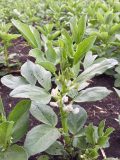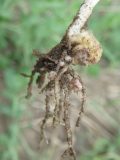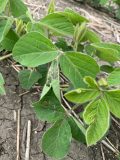June 24, 2020
- Crop update
- Scouting tips
- Mycosphaerella blight and pea fungicide decisions
- Assessing pea nodulation
- Scouting for pea aphids
- Iron deficiency chlorosis (IDC)
- Scouting for herbicide-resistant weeds
- On-Farm Network update
Listen to The Bean Report:
Crop Update
- Soybeans range from the unifoliate stage (VC) in later-seeded fields to the V4 and flower bud stages in more advanced fields. Soybean plants will begin to flower this week due to the change in day length. Symptoms of IDC are starting to pop up as more soybean crops reach the trifoliate stages. Hail over the weekend has also caused some damage to soybeans. To assess hail damage in your soybeans, click here.
- At this time last year, soybeans were at the VC to V3 stage. At this time in 2018, soybeans were at the V1 to V3 stage and VE to V2 in 2017.
- Dry beans currently range from VC to V3.
- Earlier-seeded field peas are at the 10th to 12th node stage and are beginning to flower. Later-seeded peas are currently at V7-V9.
- As peas start flowering, add nodulation, pea aphids and Mycosphaerella (Ascochyta) blight to your scouting checklist.
- Faba beans have started flowering and range from 5th to 8th node.
Scouting Tips
- Continue to assess plant stands before crops close canopy using our Bean App tool.
- As we near the end of June, cutworms will be approaching their non-feeding pupal stage. If most cutworms are at least an inch long, the population is close to pupating and control may no longer be economical. More mature plants are also more resilient to cutworm feeding.
- We’ve been seeing symptoms of root rot/seedling disease. Look for yellow or dying plants, dig up and inspect roots for discolouration, pinching or a rotten appearance – watch this quick tutorial on what you can and can’t send to the lab for testing.
- Get out to do some post-herbicide weed scouting for efficacy. Look for weed escapes and new weed flushes. Take note of species and populations to determine if another herbicide application is necessary.
- Manitoba Agriculture and Resource Development’s weekly crop report is available here. Current weather conditions and reports are available here.
- Soybean scouting resources: Soybean Insect and Disease Scouting Calendar | Soybean Plant Development Guide | Soybean Growth Staging Guide
- Dry bean scouting resources: Dry Bean Insect and Disease Scouting Calendar | Dry Bean Growth Staging Guide
- Field pea scouting resources: Field Pea Insect and Disease Scouting Calendar | Field Pea Growth Staging Guide
Mycosphaerella Blight and Pea Fungicide Decisions
 Mycosphaerella (ascochyta) blight is the most prevalent foliar disease of peas in Manitoba and the main target of foliar fungicide application. Scout for mycosphaerella and monitor the risk of disease development at the V10 (10th node) to R2 (beginning bloom) stages, during mid-June to late July. Assess the lower- to mid-canopy for symptoms.
Mycosphaerella (ascochyta) blight is the most prevalent foliar disease of peas in Manitoba and the main target of foliar fungicide application. Scout for mycosphaerella and monitor the risk of disease development at the V10 (10th node) to R2 (beginning bloom) stages, during mid-June to late July. Assess the lower- to mid-canopy for symptoms.- Use the Fungicide Decision Worksheet for Managing Mycosphaerella Blight in Field Peas to determine the likelihood of disease development.
- If you score 65 or more on the worksheet, apply fungicide at R2 (early flower). Note that peas flower from the bottom-up.
- Continue to monitor disease pressure to determine if a second fungicide application is necessary. Review research results here.
Assessing Pea Nodulation
- Dig up 5 to 10 plants at the R1 (flower bud) stage at a few spots in the field.
- Carefully remove soil as nodules on lateral roots can easily be stripped off with the soil.
- Use this scoring system to assess nodulation, as pea nodules branch out and cluster together as they develop. Take note of above-ground plant colour and vigour, nodule colour, location and the number of clusters.
- Video on scoring field pea nodulation – The pea crop in this video would score between 11 – 13 and have effective N fixation.
Note: Nodulation of soybeans and dry beans can be assessed in early July at the R1 (beginning bloom) stage.
Pea Aphids
- Scout for pea aphids during late June to early July, when 50-75% of the crop is in early flower.
- Check five plant tips (top 8 inches) or conduct 10 sweeps using a sweep net at four locations in each field (>50m apart). Pea aphids tend to feed on the youngest tissue, including the clam leaf, or newest stipule.
- The threshold in peas is 2-3 aphids/plant tip or 90-120 aphids/10 sweeps.
- If the threshold is reached, apply registered foliar insecticide at early pod (when 50% of plants have produced young pods).
- Watch for natural enemies like lady beetles, hoverfly larvae, minute pirate bugs, damsel bugs, parasitic wasps and fungal diseases.
Iron Deficiency Chlorosis (IDC)
 Symptoms: yellowing between leaf veins on young trifoliate leaves of soybeans and occasionally dry beans.
Symptoms: yellowing between leaf veins on young trifoliate leaves of soybeans and occasionally dry beans.- Caused by excess moisture, salinity, carbonates and/or high nitrate levels in the soil, impeding the uptake of iron into the plant.
- Often a temporary condition that resolves itself when soils dry up. Plants that recover by the V5 to V6 stage should have minimal yield loss.
- The best method for control is prevention, including field management and variety selection.
Scouting for Herbicide-Resistant Weeds
- Assess fields 14 to 21 days post-application.
- Look for uncontrolled weeds and variability in herbicide efficacy within a small area.
- Rule out sprayer misses, nozzle issues or environmental effects.
- If weeds were sprayed at the correct stage for control, and herbicide was applied at the right rate under the right conditions, suspect resistance and take additional steps toward confirmation. Contact Tammy Jones, Manitoba Agriculture Provincial Weeds Specialist for more information on laboratory testing and next steps.
On-Farm Network Update
Plant counts, plant counts, plant counts! That’s what is keeping the OFN team busy these days. Characterizing plant stand across trials helps us interpret yield results at the end of the season. Late season plant counts are also taken at row spacing and population trials to assess crop competition.
Toward the end of the week, we will be establishing pea fungicide trials. These trials compare untreated strips to either a single or double fungicide application at recommended label rates. This year’s fungicides include Dyax or Cotegra for the purpose of Mycosphaerella control.
Are you interested in hosting a dry bean fungicide trial on your field? It’s not too late to sign up! Contact On-Farm Network Agronomist, Megan Bourns: 204-751-0439 | megan@manitobapulse.ca
Bean App
Check out our Bean App Plant Stand Assessor and other app tools available in the App Store or Google Play!






















